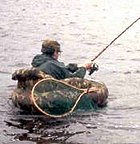
Handline fishing, or handlining, is a fishing technique where a single fishing line is held in the hands, rather than with a fishing rod like the usual angling, of which handlining is a subtype. Handlining is not to be confused with handfishing, which is catching fish by hand. When handlining, one or more fishing lures or baited hooks are attached to the line, and a fishing lure and often a weight and/or a fishing float can also be attached to the line. Handlining is among the oldest forms of fishing and is still practiced throughout the world today.
Contents

The fishing bait can be still fished, trolled or jigged up and down in a series of short movements. Often handling is done close to the bottom of the body of water but can also be done near or on the surface.

